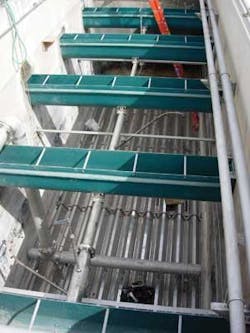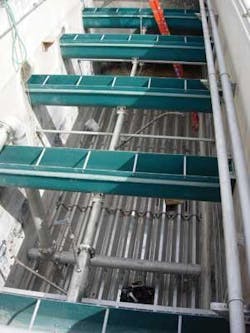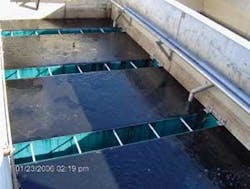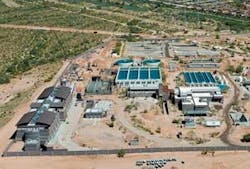By Zaid K. Chowdhury, Art Nuñez and Rick Scott
Like many communities in the United States, two Arizona cities, Scottsdale and Glendale, sought the most prudent solutions to address the Stage 2 Disinfectants/Disinfection Byproducts Rule (D/DBP Rule). This rule will change the compliance calculation method and will require cities to reduce the level of total trihalomethanes (TTHMs) at the extremities of their distribution systems. To meet compliance limits, both Glendale and Scottsdale chose granular activated carbon (GAC) systems to incrementally remove additional precursors of TTHMs. Their approach includes implementation of GAC using two different technologies; post-filter contactor facilities for the City of Scottsdale, and filter-adsorber facilities for the City of Glendale.
By locating GAC prior to disinfection, Scottsdale and Glendale avoided conversion of their secondary disinfection facilities from free chlorine addition to chloramination, thus avoiding the risk of nitrification within their warm distribution systems. GAC also provides each city a proactive barrier against other emerging contaminants that could appear in their raw water sources.
Designing a New Facility
The City of Scottsdale operates the 75 mgd Central Arizona Project (CAP) Water Treatment Plant (WTP). Water from this plant can travel more than five days to the farthest reaches of the distribution system. GAC was chosen to reduce DBPs in Scottsdale for its ability to reduce the potential for biological regrowth and to eliminate nitrification by avoiding chloramination in the warm-weather distribution system.
Scottsdale’s facility includes 11 GAC post-filter contactors, each containing 11.3 feet of GAC bed depth (430,000 pounds), providing an empty bed contact time (EBCT) of 20 minutes at design flow. A stainless steel underdrain system is used. To prevent draining and air entrainment within the media, a seal well provides a failsafe way to maintain the water level within the contactors. Similar to granular media filters designed for turbidity removal, the post-filter GAC contactors were designed with contactor-to-waste capability to avoid the possibility of a turbidity spike occurring after backwash events. The contactor-to-waste and backwash water flows can also be equalized and either sent to the residual handling facilities or recycled to the head of the plant.
Since the GAC facility would not fit within the existing plant hydraulic profile, a diversion structure and pump station had to be included. The diversion structure allows the GAC facility to be partially or totally bypassed as water quality dictates, reducing operations and maintenance costs for GAC replacement. The pump station combines diversion, GAC backwash, and service water pumping systems in one location, using water treated by the plant’s filtration facilities.
In addition, the facility design includes a network of fixed GAC transport eductors, piping, valves, and loading stations for hydraulic transfer of media, and the site layout accommodates staging of multiple tanker trucks for GAC delivery and spent GAC removal. Truck drainage and washdown water is fully contained and sent to the equalization facilities. A truck scale was also provided for verifying load weights. The configuration of the building included a drive-through filter gallery to allow easy access by truck for media replacement and mechanical equipment repair.
Construction of the $45 million GAC facility, completed in September 2008, puts Scottsdale ahead of the curve in responding to the requirements of the Stage 2 D/DBP Rule and substantially eliminates the potential for seasonal taste and odor issues. The CAP WTP is Scottsdale’s largest GAC facility, and combined with the Chaparral WTP’s post-filter adsorbers, Scottsdale supplies high quality GAC-treated surface water or groundwater to all of its customers.
Retrofitting Existing Facilities
The City of Glendale operates the 30-mgd Cholla WTP which provides drinking water to the central and southern portions of the service area. Due to the long water age and elevated water temperatures, improvements at the plant were needed to comply with the Stage 2 D/DBP Rule. Glendale opted for a filter retrofit and expansion to convert existing dual media granular filters to GAC monomedia filter-adsorbers. This would achieve removal of total organic carbon (TOC) in addition to particulate removal within a single process resulting in lower capital investment than a separate post-filter GAC process.
Implementation of GAC at the Cholla WTP and also at the newly constructed Oasis WTP provided the city the means to stay in compliance with the D/DBP Rules and supply its citizens with high quality water.
The $13 million filter retrofit and expansion project at the Cholla WTP included:
- Carbon Dioxide Addition for Enhanced Coagulation. A permanent carbon dioxide storage and feed system was included to reduce pH before or after pre-sedimentation.
- Enhanced Sludge Removal. SuperScraper™ sludge removal equipment was installed at the end of the sedimentation basins to remove sludge that historically accumulated under the finger weirs. Improving sludge removal is anticipated to reduce the release of organics into the process flow.
- GAC Filter-Adsorbers. Cholla’s four granular media filters were converted to GAC monomedia filter-adsorbers. Backwash troughs were raised to increase maximum bed depth from 39 inches to 68 inches, the underdrain system was replaced with a stainless steel underdrain that attached directly to the filter floor slab, and the carbon steel surface wash system was replaced with a stainless steel system. Pilot test results did not show any benefit to air scour for cleaning of the media over water wash alone. However, filter-adsorbers were provided with piping stubbed-out to the pipe gallery for potential future use of air scour to prevent the need to work in the filter cells. Two additional filter-adsorbers were constructed to reduce surface loading rates on the filters and to provide an EBCT of 10 minutes at design flow.
- Filter-to-Waste Capability. Filter-to-waste capability was provided for the filters, which were originally constructed in the 1970s.
- Backwash and Filter-to-Waste Equalization and Pumping. The existing backwash water equalization basin was modified to also handle filter-to-waste flows prior to pumping to the solids handling facilities.
- Turnkey GAC Services Access. GAC transfer stations were retrofitted to the exterior of the filter piping gallery. Truck drainage and washdown water is fully contained and sent to the equalization facilities.
Operations staff have experienced improved treatment performance through optimization of enhanced coagulation and chlorination processes, including reduced chemical usage. The use of GAC has already resulted in a significant decrease in TTHM concentrations within the distribution system.
null
Implementing GAC at Your Facility
It is commonly believed that the best practice for water treatment includes robust multi-barrier approach to reduce; a) microorganisms, b) natural organic matter (e.g., DBP precursors and taste and odor compounds), c) biodegradable organic matter that promote regrowth in the distribution system, and d) man-made contaminants (e.g., synthetic organic chemicals). A barrier such as GAC within a treatment plant to remove DBP precursors and emerging contaminants is a forward-looking technology that goes toward investing in water quality by the utility. Although there is still debate regarding emerging contaminants and their health effects, there is a consensus in the scientific community that GAC is one of the best treatment technologies against such potential contaminants. GAC is also recognized as the best available technology for volatile and synthetic organic chemicals found in ground and surface waters. Furthermore, GAC treatment removes taste and odor causing compounds such as 2-methylisoborneol (MIB) and geosmin and can thus improve (and protect) the aesthetic qualities of a water supply.
A variety of factors influence whether a GAC application is suitable for a particular treatment plant. Some factors that should be considering when determining if GAC is right for your facility include: a) treatment objective (i.e., the amount and type of contaminants that need to be removed), b) choice of disinfectants in the distribution system (i.e., chlorine or chloramines), and c) affordability.
About the Authors:
Dr. Zaid Chowdhury is a Vice President of Malcolm Pirnie in the Phoenix Office and serves as the Technology and Applied Research Leader for the firm’s Municipal Business Unit. Art Nuñez is the Director of Water and Wastewater Treatment for the City of Scottsdale, AZ. He is responsible for making key water treatment process decisions at the utility. Rick Scott is the Superintendant of Water Treatment for the City of Glendale, AZ. He is responsible for making and approving key water treatment process decisions.
Circle No. 211 on Reader Service Card






